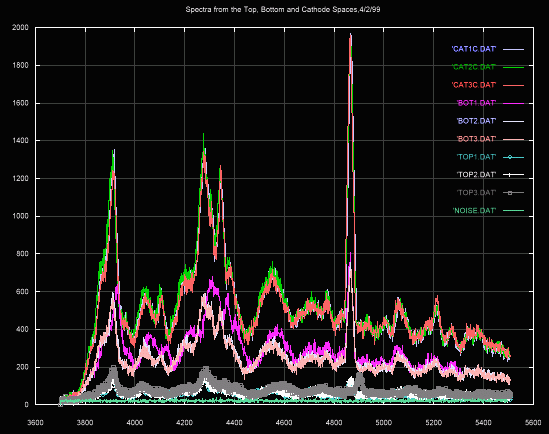Part III: Confirmation: Does it Work?
B. Results

This plot of 3 spectra each, the cathode, the bottom of the anode space
and the top of the anode space shows an encouraging relative spectral intensity
(7-10) between the cathode and the top of the anode, but only relative
intensity of slightly greater than 2.25 between the cathode and the bottom
of the anode. A good order of magnitude is desired. Since particle
density N is proportional to S^(2/3), the relative spectral densites imply
relative particle densities of only 1.71 between the cathode and the bottom
of the anode, and 4.64 between the cathode and the top. While empirical
data hardly constitutes proof, this data does suggest that the hypothesis
merits further testing.
C. Conclusions and Critiques
i. There is insufficient data to really draw any
conclusions from except that more data is needed. While the plot
above isn't the only set of data from the project, it was some of the best.
Data taking has been a slow process, subject to many probable sources of
error. Among these are:
a.) The optical path between the bell jar and spectrometer varies
between sessions. It is almost impossible to get the same exact alignment
for a given afternoon session.
b.) Even during the same session, the utmost care must be excersised
to insure that the mirror is aligned to give the maximum intensity possible
for a given viewing port.
c.) The thermocouple gauge is still highly suspect. A thorough
calibration is in order. The general level of glow in the device
suggests that the pressure might still be above 10 microns. The resistance
across the chamber is too low. It shouldn't draw hardly more than
1 or 2 mA at a voltage under 15kV. Higher order confinement depends
in part on a long mean free path for the ions, which requires low pressure.
d.) The ion optics of the system were extremely crude. All
data taken to this date was with the welded wire cathode and the anode
simply hung on 10-32 all-thread rods for support. The real miracle
is that it ever worked at all.
ii. In spite of the flaws in the system mentioned
above, the device behaves as a good prototype of the sort documented
in Richard Hulls "Fusor! An Introduction", which was the first source
of material on this subject encountered by this author. Because the
prototype is apparently behaving as expected, it is reasonable
to conclude that the problems with the current system can be surmounted.



